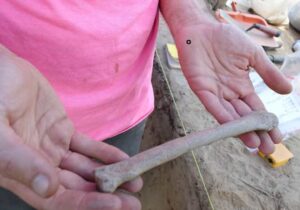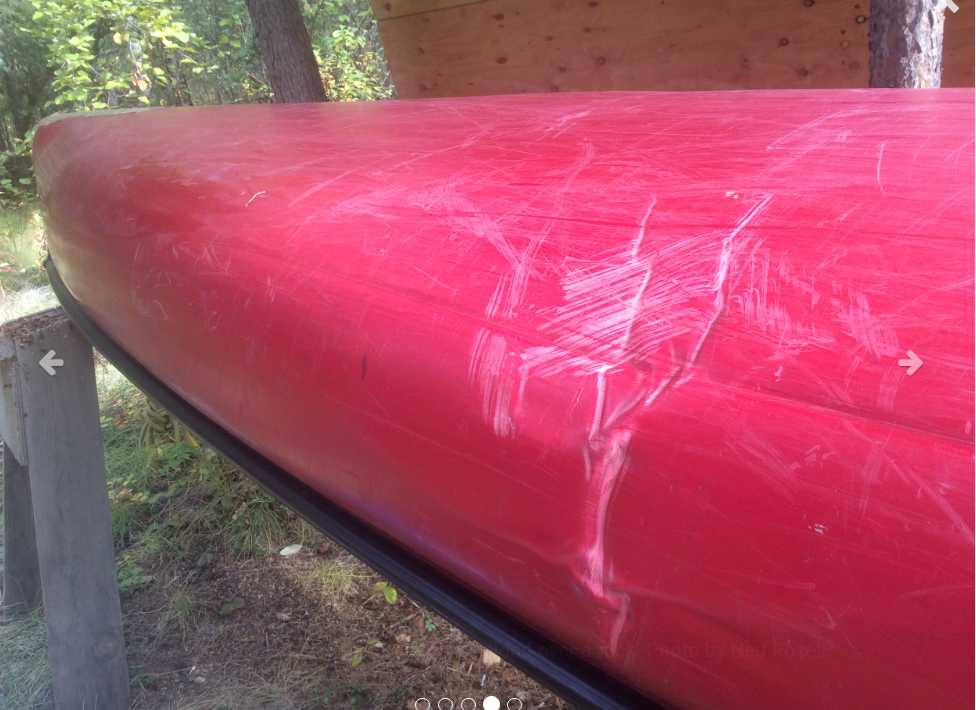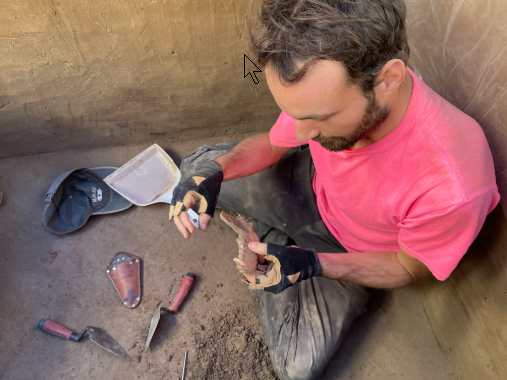
DELTA JUNCTION — On this rock outcrop 30 feet above the gray Tanana River and green hayfields cleared from the forest below, archaeologists have possibly found evidence of the canine companions of early Alaskans.
Eight students and professionals are now troweling the floury tan soil of Hollembaek’s Hill to learn more about the distant past of middle Alaska.
Within the soil on top of that bluff, a team of archaeologists from the University of Alaska Fairbanks and other institutions have unearthed a reddish stain that might be the residue of an ancient dwelling.
From the diggings, they have recovered charcoal, chips of stone tools, and many bones and bone fragments, including some from canids that may be wolves or dogs.
They think the latter may be possible — isotope analyses they have performed on the bones shows those canids were eating salmon.
“It suggests people were catching salmon, storing it for winter and feeding it to wolves or dogs,” said François Lanoë, an archaeologist with both the University of Arizona and UAF who has worked at the site for several summers.
Charcoal from the possible “house pit” on Hollembaek’s Hill dates to 8,000 years ago, said archaeologist Josh Reuther of the UA Museum of the North, who is supervising the excavation.
“This site fills a gap in dates when people were in the area,” he said.
Other archeological sites in middle Alaska that are helping paint the picture of how people migrated to the Americas (and then lived here) are: Nearby Swan Point (with evidence of people from 14,000 years ago), Upward Sun River (11,500 years ago), Tangle Lakes (4,500 years ago), Swan Point (2,000 years ago), Pickupsticks (900 years ago) and Mansfield Village (500 years ago).
The 8,000-year-old house pit the scientists are excavating at Hollembaek’s Hill might have been a shelter that resembled a dome tent. The poles might have been bent saplings. In summer, people covered that frame with spruce bark and in winter with animal hides.
From within their excavation into the rockless, powdery soil deposited by wind during the retreat of Alaska Range glaciers, the researchers have found preserved bones of geese, ducks, whitefish, salmon, burbot, pike and beaver.
They have also unearthed 10 bones of adult dogs or wolves, as well as one canine fetus. If the creatures were dogs, the evidence for man’s best friend would be some of the earliest uncovered on the continent.
“Did the First Americans 14,000 years ago bring dogs (across the Bering Land Bridge) with them?” Lanoë said. While he talked, Lanoë held up a canid bone unearthed at the site by UAF graduate student Korovin Ellis.
The ancient canines of Hollembaek’s Hill were joined there recently by a dog owned by Scott and Ruby Hollembaek. The Hollembaeks are farmers who years ago invited archaeologist Chuck Holmes to excavate on their property. They buried their pet on the hilltop a few years ago.
The Hollembaeks continue to allow researchers to work on the site. In return, they get to learn the secrets the bluff has to tell.
Scott Hollembaek hiked up the bluff on a recent sunny day to check on the archaeologists and enjoy one of the best views in Interior Alaska.
While up there, he looked down over the 2,000 acres of hayfields in which he raises bison and elk. The last time those creatures lived there in great numbers was right after the end of the last ice age. Those thousands of years ago, people might have looked down from that same perch in search of game, with warm, furry bodies pressed against their sides.
Since the late 1970s, the University of Alaska Fairbanks’ Geophysical Institute has provided this column free in cooperation with the UAF research community. Ned Rozell is a science writer for the Geophysical Institute.
[content id=”79272″]






